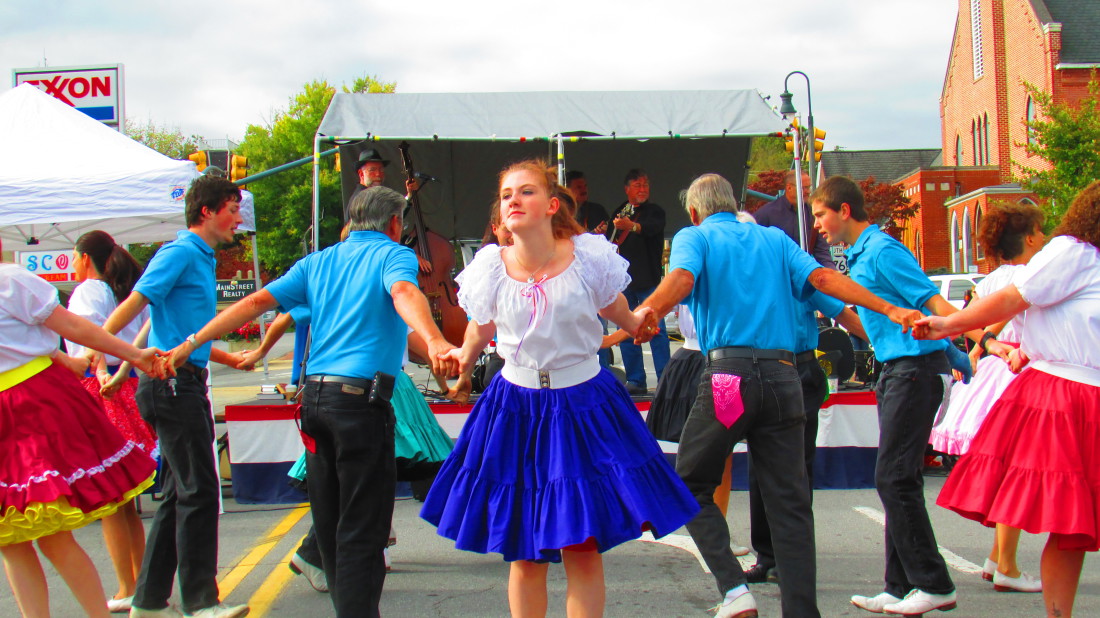With folk dancers from Taiwan, Trinidad, Romania, Russia and other far-flung places performing at Folkmoot, it might be easy to overlook the fact that southern Appalachia has its own dance custom to share. Dressed in their full crinoline skirts and tap shoes, four Appalachian clogging teams represent the mountain tradition at the international folk dance festival.
“It used to be you could tell whether a [clogging] team was from Haywood or Buncombe county just from their beat,” says Shirley Finger, director of the Dixie Darlin’ clogging team in Waynesville, who will participate in Folkmoot this year for the second time.
These days, the dance is typically performed for competitions and showcases. It originated as major entertainment in isolated Appalachian villages. “On Saturday night, everybody would get together,” says Finger. “[Clogging] was a social event, but now it’s dwindling down. I hate to say that, but it is. Used to be, you’d get to Maggie Valley, and there would be two rings [of dancers]. There would be so many people, you couldn’t fit them all in.” Along with the Dixie Darlin’ team, the Southern Appalachian Cloggers, The J Creek Cloggers and the Green Grass Cloggers will perform throughout Folkmoot at venues like Haywood Community College and the Stompin Grounds in Maggie Valley, Friday, July 18 through Sunday, July 27.
Appalachian clogging is a unique blend of Irish jig, English step dancing, African rhythms and Native American dance. It’s characterized by quick, percussive footwork, an erect upper body and an old-time, bluegrass beat. These days, most teenagers aren’t likely to spend their weekend nights clogging, but the dance is far from extinct.
Kim Ross, director of the J Creek Cloggers, says dancers on her team range from 10 to 81 years old. Ross grew up buck dancing and flat-footing — two close relatives of traditional clogging — in Virginia before moving the Western North Carolina 20 years ago. Small differences in dance style across county and state lines are indicative of how the tradition is passed from parents to children. “Even state to state it’s different,” says Ross. “I think it just depends what part of the country you were raised in.” For instance, says Ross, she had never had a set of taps on her shoes before moving to WNC, which is common with most regional groups.
Finger says that the Dixie Darlin’s style is more traditional than most. “We do it the old way … close to the floor, the old figures. Now don’t get me wrong, they’re very high-energy, but we still do the true southern Appalachian [style],” she says. “Most of our [dancers] are from here, and that’s what they’ve grown up with. … That’s why I say it’s true southern Appalachian mountains. It’s what their parents did, the same way they did it.”
But the real key to the traditional style is the rhythm, says Finger. “You’ve got to have that southern Appalachian beat. I don’t know to describe it. It’s something that thank God we’ve got.”
The differences between clogging forms may seem tiny compared to the differences among the international dancing teams at Folkmoot. But differences in costume, dance steps and even language don’t stop the dancers from sharing their moves and getting to know one another. Ross recalls dancing with a Canadian team at last year’s Folkmoot: “We had a big square dance and brought everyone into it,” says Ross. “The Canadian dancers did more of a jig instead of an actual clog, so that was something different — but we all had the same beat. That’s what was really neat. The Canadian bands played an old town mountain song for us, and my group combined with the Canadians, and we all kept the same rhythm. It was really the neatest thing I’d ever seen.”
Both Finger and Ross recall past Folkmoot festivals where the different dance teams enthused over each others’ styles and costumes, asking about shoes and steps. “Even though we can’t communicate in English, music and dance can bring the world together,” says Ross. “We’ve had groups jump up and dance with our traditional music, we’ve jumped up and tried to dance with their music. And even though we can’t communicate well, we can all hold hands in a circle and dance and have a good time.”
WHAT: Folkmoot USA
WHEN: Friday through Sunday, July 18-27
WHERE: Multiple locations including the Stompin’ Ground in Maggie Valley, the Diana Wortham Theatre and the Cherokee Indian Fairgrounds. Tickets range from $0-$30 depending on the event. Info at folkmootusa.org




Before you comment
The comments section is here to provide a platform for civil dialogue on the issues we face together as a local community. Xpress is committed to offering this platform for all voices, but when the tone of the discussion gets nasty or strays off topic, we believe many people choose not to participate. Xpress editors are determined to moderate comments to ensure a constructive interchange is maintained. All comments judged not to be in keeping with the spirit of civil discourse will be removed and repeat violators will be banned. See here for our terms of service. Thank you for being part of this effort to promote respectful discussion.